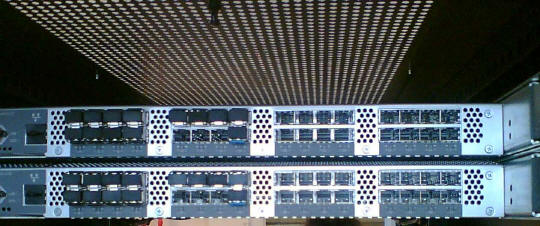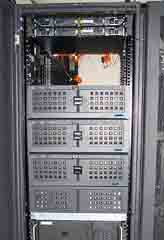SAN: Storage Area NetworksDefinition: A SAN is a dedicated network that is separate from LANs and WANs. It is generally used to connect all the storage resources connected to various servers. It consists of a collection of SAN Hardware and SAN software; the hardware typically has high inter-connection rates between the various storage devices and the software manages, monitors and configures the SAN. | |||
| |||
 From webopedia: Storage Area Network (SAN) is a high-speed subnetwork of shared storage devices. A storage device is a machine that contains nothing but a disk or disks for storing data. A SAN's architecture works in a way that makes all storage devices available to all servers on a LAN or WAN. As more storage devices are added to a SAN, they too will be accessible from any server in the larger network. In this case, the server merely acts as a pathway between the end user and the stored data From Enterprise Storage Forum: A SAN is a network of storage devices that are connected to each other and to a server...in some configurations a SAN is also connected to the network. ... it is forecast to become the data storage technology of choice in the coming years. SANs originated to overcome the problems with network attached storage (NAS) devices, which - like ordinary servers - are difficult to manage and difficult to expand the capacity on. NAS devices also add to the traffic on the network and suffer from the delays introduced by the operating systems' network stacks. A SAN is made up of a number of fabric switches connected in a  network. The most common form of SAN uses the Fibre Channel fabric protocol (with Fibre Channel switches). Alternatively ISCSI could be used with IP switches. network. The most common form of SAN uses the Fibre Channel fabric protocol (with Fibre Channel switches). Alternatively ISCSI could be used with IP switches. Connected to the SAN will be one or more Disk array controllers and one or more servers. The SAN allows the storage space on the hard disks in the Disk array controllers to be shared amongst the servers. More on Storage Area Network NAS-SAN comparisons |
Hi friends and dear customers today network is wide range one and lot of job opportunities in this field. this blog consist of "what is network and its consistence".i hope that you viewers you will support me and follow my blog.
Popular Posts
-
A TOSLINK optical fiber cable with a clear jacket. These plastic-fiber cables are used mainly for digital audio connections between d...
-
A network interface card (NIC) is a computer circuit board or card that is installed in a computer so that it can be connected to a ne...
-
Hubs are of two types active hub and passive hubs; ACTIVE HUB &PASSIVE HUB A Passive Hub is just a connector. It connects the wir...
-
An Internet Protocol address ( IP address ) is a numerical label that is assigned to any device participating in a computer network that u...
-
Twisted pair cabling is a type of wiring in which two conductors (the forward and return conductors of a single circuit ) are twisted toge...
-
Grid computing is a term referring to the combination of computer resources from multiple administrative domains to reach a common goal. Th...
-
A network is basically a set of two or more articles that are linked so the computers can share resources, such as printers, software , a...
-
A hybrid cloud is a cloud computing environment in which an organization provides and manages some resources in-house and has others prov...
-
Network topology is the layout pattern of interconnections of the various elements ( links , nodes , etc.) of a computer network . [1] [2] ...
Monday, November 8, 2010
SAN(storage area network)
Subscribe to:
Post Comments (Atom)







No comments:
Post a Comment